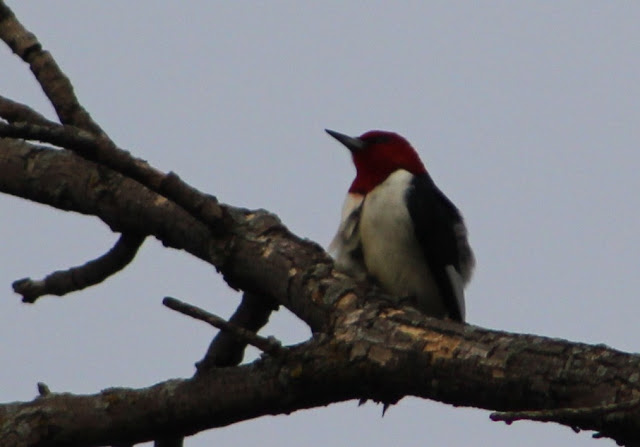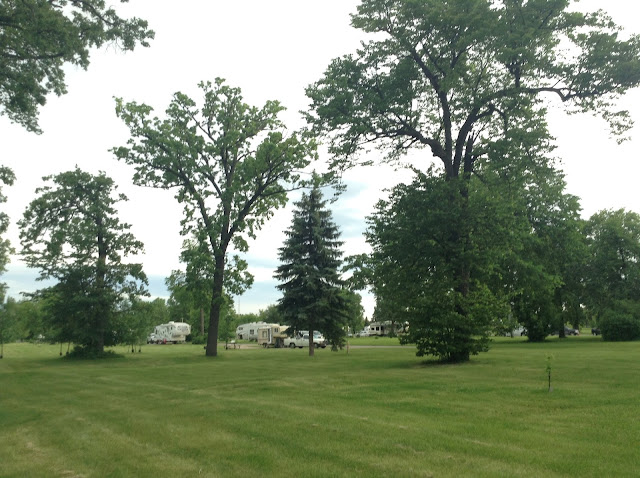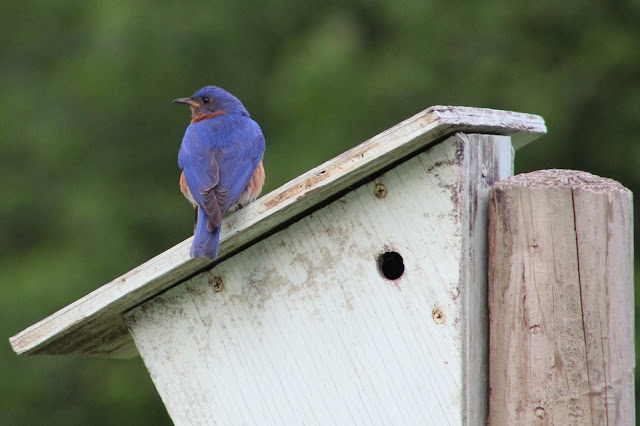I shot this picture from far away but one can still easily see that this bird has a bright red head. Sandy was showing me my first ever Red-headed Woodpecker! This woodpecker was one I tried for less than two weeks prior in Arizona's Santa Rita Mountains without luck. As Red-headed Woodpecker is a big vagrant in Arizona, it's expected in Minnesota and it's still a big deal. This woodpecker is very striking, and with it's bright red head, black back, white front and underparts, and bright white secondaries to contrast on it's black wings, it makes it one of North America's most distinctive woodpeckers (birds for that matter) in an instant glance.
The Red-headed Woodpecker is also easy to identify in it's range because it is the only woodpecker that has a red head out of the other breeders (the west has a red-headed woodpecker species too!). Red-headed Woodpeckers are impressive to watch in flight, where they will do a lot of their hunting from. Hunting techniques also include ground feeding and gleaning from tree limbs and trunks. I was very impressed with Sandy from the start of the outing and I was excited that the Red-headed Woodpecker is now on my life list!
After enjoying the Red-headed Woodpecker for about ten minutes, Sandy and I headed west and northwest into Grand Forks, North Dakota to begin our Short-eared Owl prowl. This post will cover most of the other birding we did other than the owling now that I've already written about the owls. We headed off into an area called Kellys Slough National Wildlife Refuge, where we spent most of our time birding in and around the Refuge. Birds were everywhere, and I got to enjoy several life birds as well as seeing some birds on their breeding grounds for the first time that I've seen in Arizona in winter. After seeing a few Brown Thrashers on this trip, it was neat to see one out in the open. This is a bird that is commonly known of as a skulker, but this time, it was saying "cheese".
Eastern Kingbirds and Bobolinks were everywhere in their favorite habitats. While focused on the owls, I didn't think much about stopping and looking at them after getting good views of them earlier in the day when birding Kandiyohi County with Josh. I did ask Sandy to stop when this Eastern Kingbird was almost sitting on the road. Gosh, Eastern Kingbirds are cool. (Josh says the same thing about Western Kingbirds).
Sandy then pointed out the voice of a new life bird to me, the Le Conte's Sparrow. Le Conte's Sparrows are secretive little sparrows consistent with those in the Ammodramus genus. These sparrows live in tall grass, and are very hard to see most of the time. After some looking, Sandy spied a Le Conte's Sparrow sitting on top of a grass perch that she was able to get her scope on. The scope views of the Le Conte's Sparrow were killer, and I got to see the colorful sparrow well through the scope. It was out of my camera's range, but I did take video of the bird singing with my iPod. If sparrows were the main target, then I know Sandy would have found a closer Le Conte's easily, because she's awesome like that. Here is a video of the Le Conte's Sparrow singing.
The Le Conte's Sparrow wasn't the only sparrow that was a major highlight, there were actually several. One more of those was an even more secretive sparrow in that same genus, the Nelson's Sparrow. The Nelson's Sparrow has a short and harsh sounding song, and it was only the second time in my life that I have detected a Nelson's, thanks to Sandy. It was neat to be in it's breeding grounds and to hear it sing. My first Nelson's observation came in San Diego several years ago, where Dominic Sherony and I had killer looks at a few of them.
Something else very cool was hearing Wilson's Snipes give their winnowing sounds which the male makes from his tail feathers. This sound sounds similar to the call of a Boreal Owl, and it's strange to think what it's really coming from. Sandy and I heard the snipes calling from the wet fields and marshes numerous times during our search, and one of them kindly perched up on a post for us.
Prairies are peaceful to bird in and are beautiful.
In the prairies, marshes, and open wetland habitats we drove through and looked over, Sandy and I also encountered a Tundra Swan, Blue-winged Teal, Northern Shovelers, Redhead, Ring-necked Pheasant, a group of Sharp-tailed Grouse, heard-only American Bitterns, Northern Harriers, Sora, Marbled Godwit (flew out of the prairie and called loudly at Sandy's passing vehicle), Wilson's Phalarope in a small pond, Ring-billed Gull, a Western Kingbird, Sedge Wrens, a Gray Catbird, Clay-colored, Vesper, and endless Savannah Sparrows; Red-winged Blackbird, Yellow-headed Blackbird, and Western Meadowlark.
Sandy also gave me two more life birds for the outing. One was another sparrow, and another Ammodramus sparrow at that. This second sparrow lifer was a Henslow's Sparrow. Henslow's Sparrows are rare in this part of North Dakota in Grand Forks County, with the last one being recorded in the area in 1999. A Henslow's Sparrow was found in a reliable spot this year where Sandy has seen it several times. After Sandy and I drove by the spot a few times during our outing, we missed the Henslow's Sparrow. The third try proved to be a charm and we heard the Henslow's Sparrow immediately. Sandy described the song as if the sparrow was singing, "Hick-up". The two syllable song the sparrow sang out made Sandy's description a spot on statement! As the bird sang, Sandy spied it and for the second time of the day, she gave me excellent scope views of a lifer sparrow. Seeing the Henslow's through the scope well was a great experience, as well as seeing a Henslow's where they are considered rare. Here is a sound recording I made of the bird singing, "Hick-up".
As I mentioned in one of my previous posts, the Short-eared Owling was incredible. Sandy was right on about everything with Short-eared Owls and if it weren't for her knowledge, than Short-eared Owl searching would have to wait until later in the year. Here's a picture (one I actually didn't use yet) as a reminder about how awesome the owling was as the sole focus of the outing...
As it was about to get dark over the area, Sandy took me to a damp field where she has heard another life bird for me, the Yellow Rail. The Yellow Rail is a tiny rail, and it, along with the tiny Black Rail, are two of North America's toughest birds to see. However, they aren't so hard to hear. Yellow Rails favor tall and damp grass fields for their habitat, and seeing one requires almost 100 percent of luck. Birders will try and walk towards calling birds and will somewhat get on all sides of the bird to attempt at seeing the bird fly. Yellow Rails do have distinctive white patches on their wings that are distinctive when they are seen in flight. Sandy and I were happy with a heard bird, and it didn't take long for a Yellow Rail to start calling. The call sounds similar to someone hitting rocks against rocks. I stood there and listened to the Yellow Rail with Sandy for about ten minutes, and I managed to get this sound recording:
My time with Sandy was incredible, thank you much Sandy! Getting four life birds was fantastic, as well as getting my main goal for the entire trip, the Short-eared Owl. Sandy delivered success to me, and it couldn't have ended better than our last bird of the night being a Short-eared Owl...
After Sandy dropped me back off at the campground I was staying at in East Grand Forks in Minnesota, I got some sleep and still had some major birding to do on my home on June 11th. I had some ideas, but sadly, they crashed. I opted into walking around the campground within the Red River State Recreation Area. As I write now, I wish I would have gone back to where Sandy and I went for a few hours. But some of the birds within the campground were solid, including more of the Red-headed Woodpecker.
Red River State Recreation Area was lined with campsites, 100 in all. There weren't very many open spots. Yeah, Kellys Slough would have been a much better choice Tommy, you idiot.
But the Red River itself was pretty cool...
One of my highlights was this Common Grackle, which is probably every Minnesota birders' lowlight.
This Chimney Swift flew overhead. As you can see, it was quite cloudy on this morning.
Something else that pulled me aside was this male Eastern Bluebird on a bluebird box. For the easterner, its a classic backyard sight to have a bluebird box and a bluebird to go along with it. I swear, I felt like I made my own history in so many ways on this trip!!!!!!!!!!!!!!!!!!!!!!!!!!!!!!!!!!!!!!!!!!!!!!!!!!!!!!!!!!!!!
A female Wood Duck also flew by.
Here's one more of the Red River.
Stay tuned for at least seven more posts from my Minnesota vacation. There's a lot yet to come. Up next, I visit an awesome spot on my way back to the Wallestad's home from Grand Forks at a Minnesota hot spot that Josh thought I should visit. And I promise, this spot will be a good one...






























Your idiot comment and professed adoration of the COGR cracked me up. It's good to see you had fun with that bottom shelf stuff. And the top shelf stuff--that was some impressive sparrowing! Looks at three Ammodramus Sparrows is unreal! And you know, a Yellow Rail is okay too.
ReplyDeleteI found myself laughing at my comments I made towards those two things too, is that bad or what? I guess MN birding is a win-win for me with stuff on all shelves. I want to SEE a Yellow Rail now and a Black Rail...
Delete